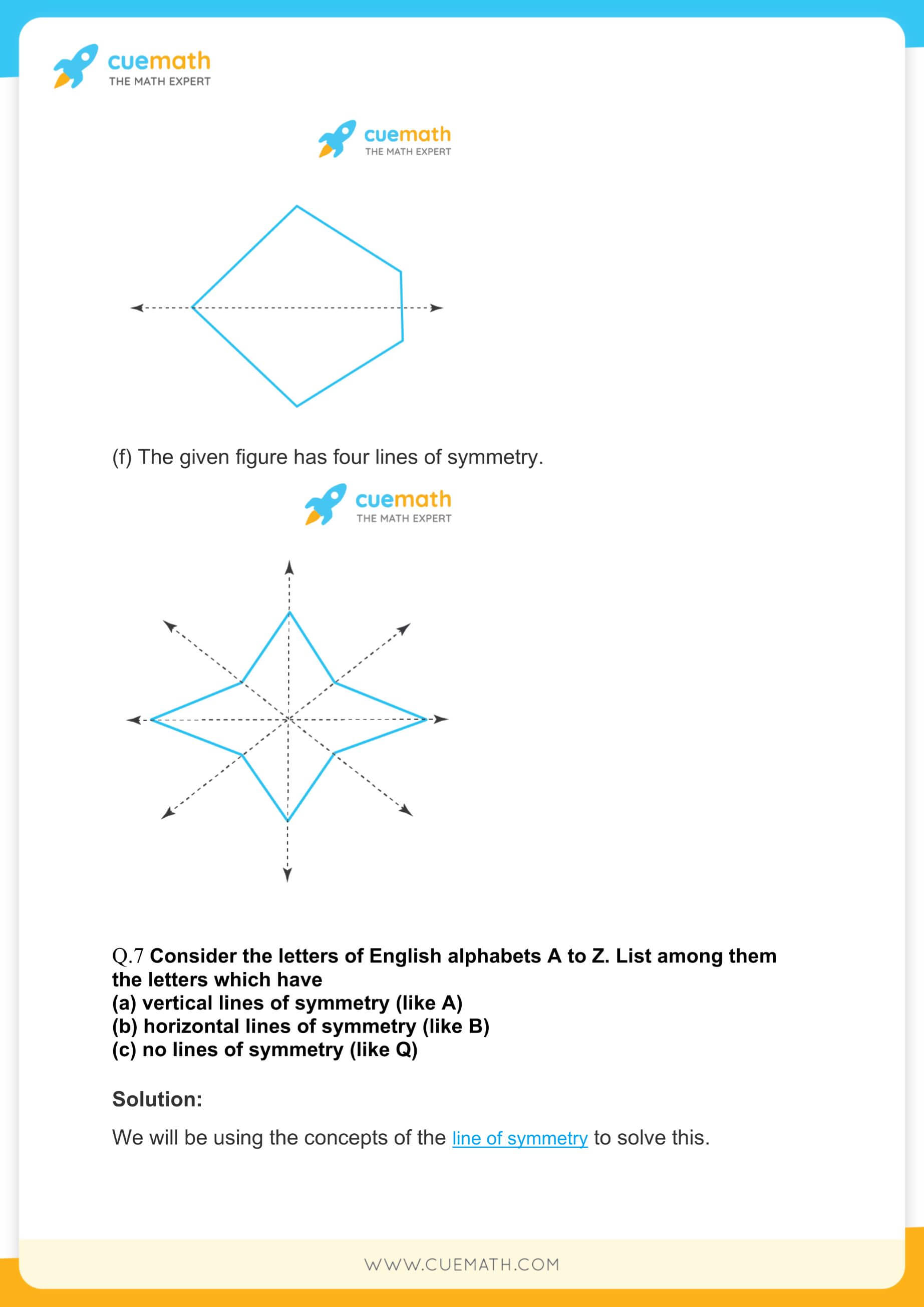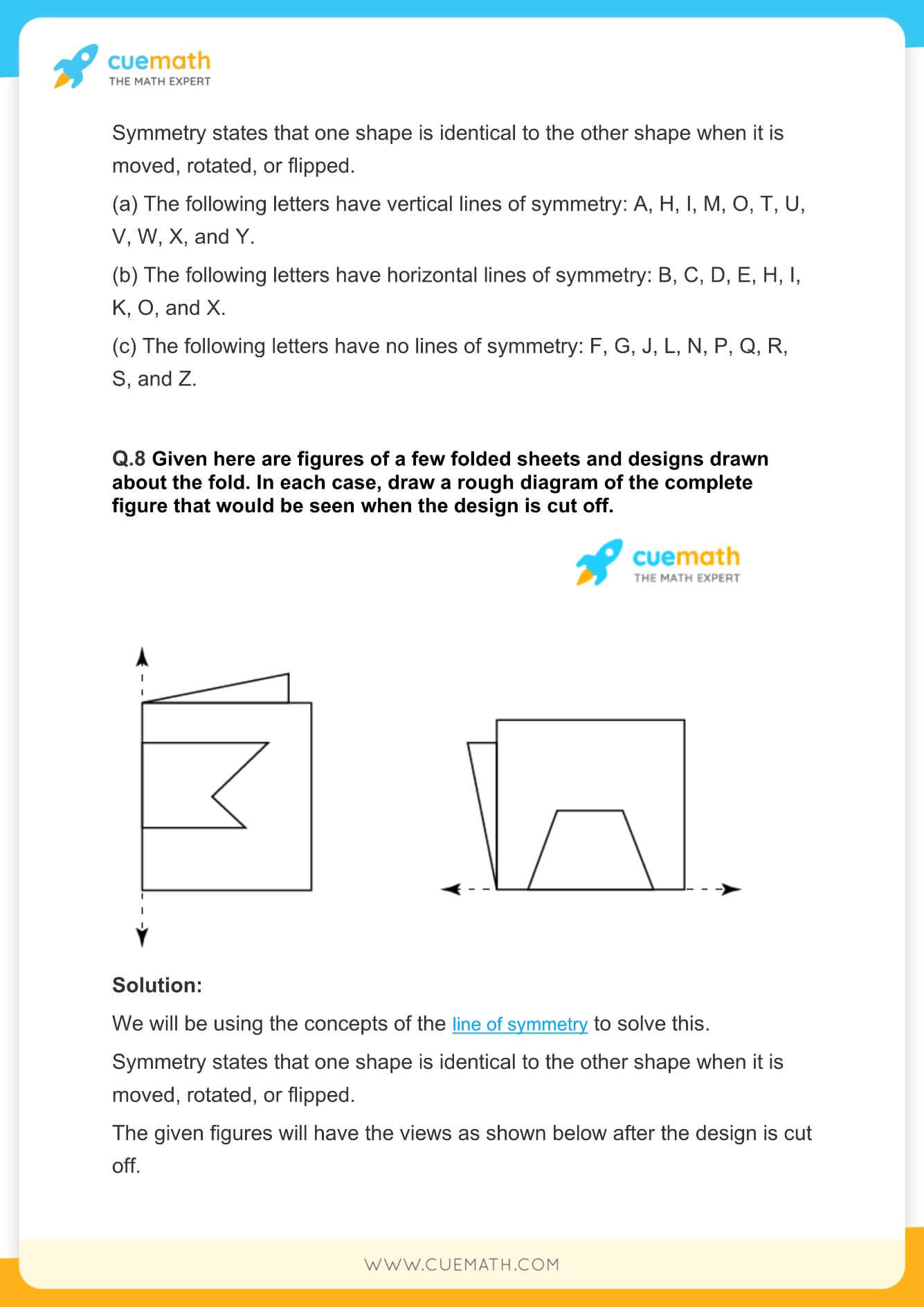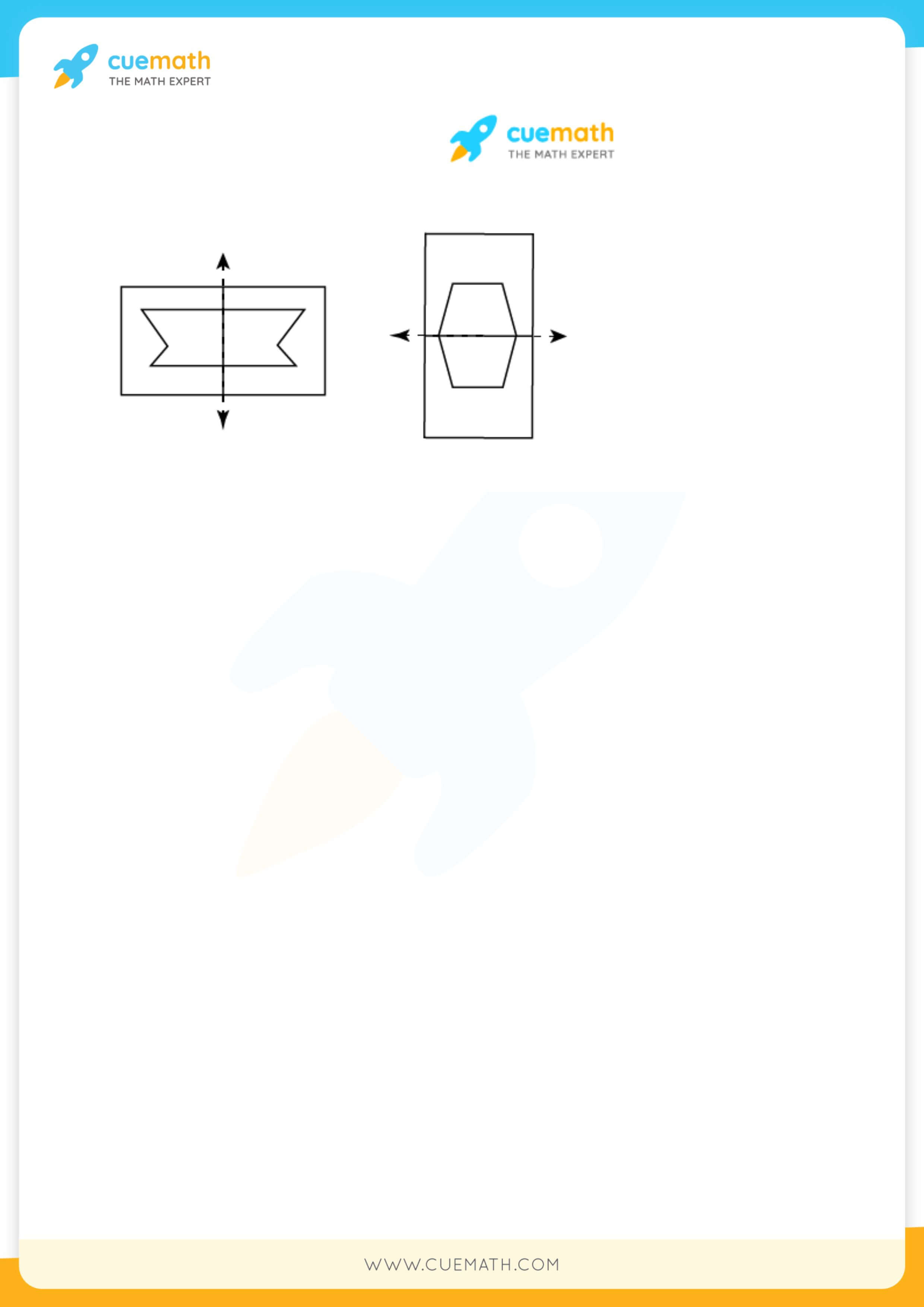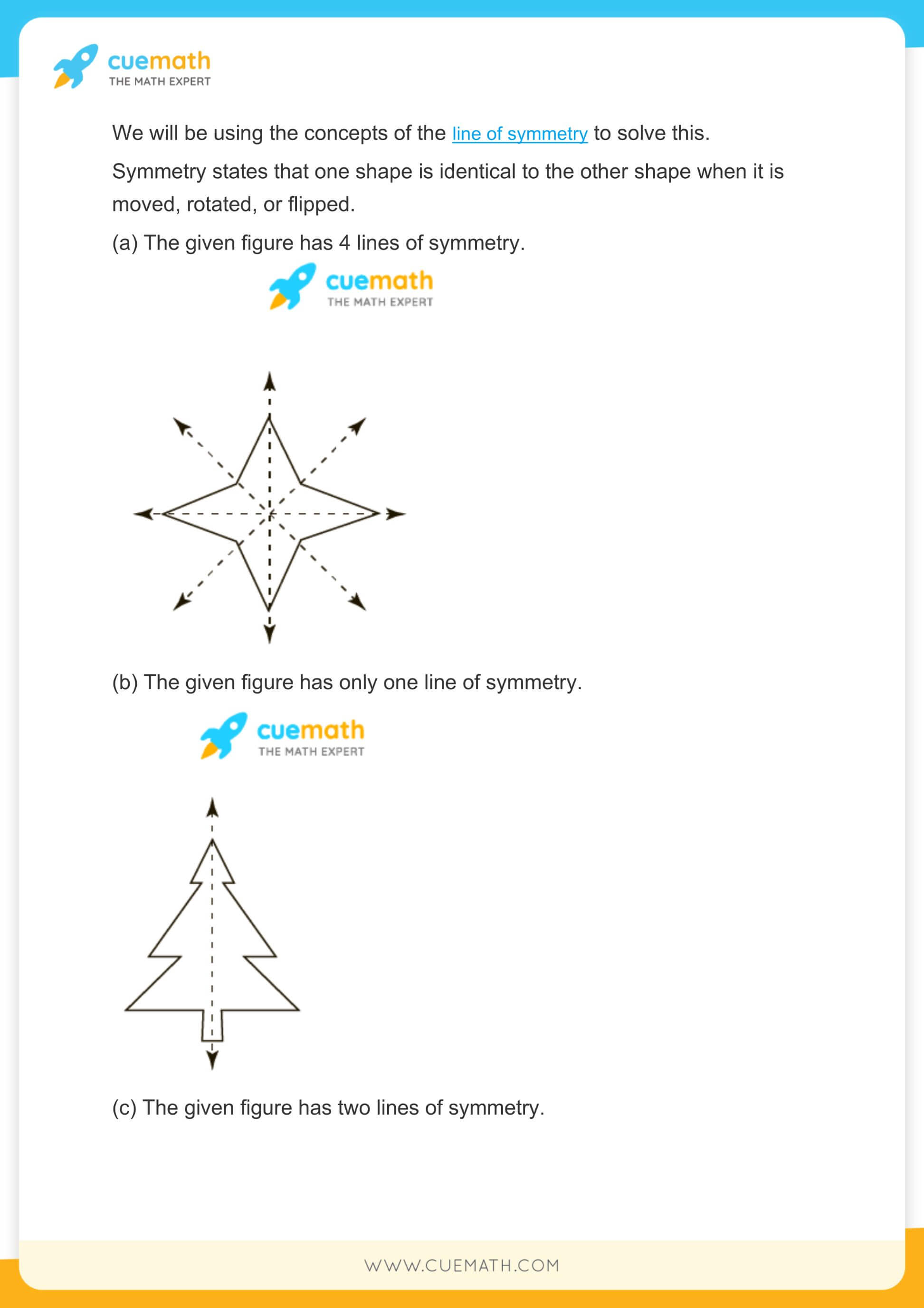NCERT Solutions Class 6 Maths Chapter 13 Symmetry
NCERT Solutions for Class 6 Maths Chapter 13 symmetry presents the concept of symmetry through its presence in everyday life and also its application in various fields. Symmetry in mathematics is significant because it is one of the key components of geometry. The role of line symmetry is elaborated broadly in this chapter. Line of symmetry refers to the line that divides a figure into two identical parts. A figure may have no line of symmetry, only one line of symmetry, two lines of symmetry, or multiple lines of symmetry. Moreover, the chapter explains how line symmetry is closely related to mirror reflection. When dealing with mirror reflection, we have to take into account the left ↔ right changes in orientation. Furthermore, symmetry has plenty of applications in everyday life, especially in the beautification of structures, art, architecture, textile technology, design creations, geometrical reasoning, Kolams, Rangoli, etc. The key feature of NCERT Solutions Class 6 Maths Chapter 13 symmetry is that it forms the basis to understand several concepts in mathematics, especially geometry.
NCERT solutions class 6 Maths symmetry employs various methods used in determining the symmetry of different geometrical shapes, wherein the number of lines of symmetry is elaborated through various examples. For finding the lines of symmetry, the figures are observed and answers are formulated. The Class 6 Maths NCERT Solutions Chapter 13 has been provided by subject experts. We are about to perform a complete analysis of NCERT answers Chapter 13 Symmetry with the help of this article. Let us get started and also you can find some of these in the exercises given below.
- NCERT Solutions Class 6 Maths Chapter 13 Ex 13.1
- NCERT Solutions Class 6 Maths Chapter 13 Ex 13.2
- NCERT Solutions Class 6 Maths Chapter 13 Ex 13.3
NCERT Solutions for Class 6 Maths Chapter 13 PDF
One of the key concepts covered in the NCERT solutions for class 6 Maths Chapter 13 Symmetry is majorly based on the knowledge of the line of symmetry, which divides an object or figure into equal parts. Symmetry acts as the fundamental concept for several geometrical problems. Any figure can be said to be symmetric if it has evenly balanced proportions. This chapter focuses on developing students’ visual skills which will be crucial to their success in upcoming classes. Solving all of the questions in the NCERT coursebook is the only way to obtain profound knowledge of the concepts outlined in this lesson. Additionally, all of the questions' exercise-by-exercise solutions are available as a free pdf download. Here are some links to help you out:
☛ Download Class 6 Maths NCERT Solutions Chapter 13 Symmetry
NCERT Class 6 Maths Chapter 13

































NCERT Solutions for Class 6 Maths Chapter 13 Symmetry
Practicing consistently is the only method to improve your knowledge. As a consequence, students must revisit the provided links and solve all the problems on their own. The solutions have been listed in a step-wise and detailed manner along with additional study tips to help kids streamline their studying process. All NCERT Solutions Class 6 Maths Chapter 13 Symmetry is subdivided in a step-by-step and comprehensive manner below.
- Class 6 Maths Chapter 13 Ex 13.1 – 6 Questions
- Class 6 Maths Chapter 13 Ex 13.2 – 8 Questions
- Class 6 Maths Chapter 13 Ex 13.3 – 3 Questions
☛Download Class 6 Maths Chapter 13 NCERT Book
Topics Covered: The topics covered under class 6 Maths NCERT Solutions Chapter 13 Symmetry are identifying symmetrical shapes and objects, figures with two lines of symmetry, multiple lines of symmetry in figures, the existence of lines of symmetry everywhere, such as in road signs, deck of cards, starfish, crab, etc., the correlation of reflection and symmetry, symmetry in paper decoration and Kaleidoscope.
Total Questions: NCERT solutions for class 6 maths chapter 13 symmetry has 17 questions out of which 6 are difficult, 8 are easy and 5 are of an intermediate level.
List of Formulas in NCERT Solutions Class 6 Maths Chapter 13
NCERT solutions for class 6 Maths Chapter 13 Symmetry contains concepts that are essential for getting a more comprehensive understanding of symmetry. This chapter does not contain any specific formulas. We'll look at how to identify symmetry in a variety of geometrical shapes and figures that we see in everyday life. Some of the examples of objects having different numbers of lines of symmetry are given below:
- Scalene Triangle - No line of symmetry as it has unequal sides.
- Isosceles Triangle - 1 line of symmetry because two sides are equal.
- Rectangle - 2 lines of symmetry namely, horizontal and vertical.
- Equilateral Triangle - 3 lines of symmetry as all sides are equal.
Important Questions for Class 6 Maths NCERT Solutions Chapter 13
| CBSE Important Questions for Class 6 Maths Chapter 13 Exercise 13.1 |
|---|
| CBSE Important Questions for Class 6 Maths Chapter 13 Exercise 13.2 |
|---|
| CBSE Important Questions for Class 6 Maths Chapter 13 Exercise 13.3 |
|---|
FAQs on NCERT Solutions Class 6 Maths Chapter 13
Why are NCERT Solutions Class 6 Maths Chapter 13 Important?
NCERT Solutions Class 6 Maths Chapter 13 has been developed by subject experts for students. These solutions provide students with not only a reliable method of evaluating their responses but also a step-by-step solution to all questions. As these solutions have elaborate explanations kids can improve their knowledge and build a robust mathematical foundation using these.
Do I Need to Practice all Questions Provided in NCERT Solutions Class 6 Maths Symmetry?
It is essential that students practice the NCERT Solutions Class 6 Maths Symmetry regularly. This will help kids enhance their visualization skills. All the questions help children get an understanding of a new topic or support revision of a previous section with advanced level sums. Thus, students must devote an equal amount of time to all sums without skipping any.
What are the Important Topics Covered in Class 6 Maths NCERT Solutions Chapter 13?
All topics that fall under the NCERT Solutions Class 6 Maths Chapter 13 are equally important. Identifying symmetrical shapes and objects, a figure with two lines of symmetry, several lines of symmetry in figures, the existence of lines of symmetry everywhere, the relationship between reflection and symmetry, the symmetry in paper design, and Kaleidoscope are among the topics covered. Students must, however, spend sufficient time in understanding the applications of symmetry as well as developing their visualization skills.
How Many Questions are there in NCERT Solutions Class 6 Maths Chapter 13 Symmetry?
The NCERT Solutions Class 6 Maths Chapter 13 Symmetry has 17 questions divided into three exercises. The first exercise involves determining the line of symmetry in various figures and objects. The second exercise involves determining the number of multiple lines of symmetry in several geometric shapes and everyday objects. The final exercise explores the association between symmetry and reflection, symmetry in paper design, and the Kaleidoscope.
How CBSE Students can utilize Class 6 Maths NCERT Solutions Chapter 13 effectively?
Students must first go over the textbook's conceptual topics and solve problems before using the NCERT Solutions Class 6 Maths Chapter 13 proficiently. This lesson discusses how to put a concept into practice. Students must solve the practice questions and then use the solutions to double-check their procedures and results.
Why Should I Practice NCERT Solutions Class 6 Maths Chapter 13 Symmetry?
To learn how to determine the symmetry in various figures and objects in geometry as well as everyday life, students should practice NCERT Solutions Class 6 Maths Chapter 13 Symmetry. Kids are able to get an understanding of simple but practical concepts such as the working of a mirror and the corresponding reflection. Additionally, by practicing all sums students can all maximize the probability of getting a good score in the examinations.
visual curriculum